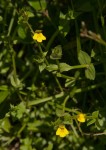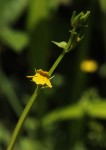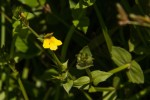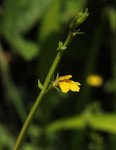Crepidorhopalon flavus
Selected images: Click on each image to see a larger version and details of the record View all images (4)
Detailed records: Display species records QDS maps by: Google Maps Point records by Google Maps
Species details: Click on each item to see an explanation of that item (Note: opens a new window)
| Synonyms: |
Crepidorhopalon whytei sensu Mapaura & Timberlake in Sabonet 33: 77 (2004) Lindernia flava S. Moore Lindernia whytei sensu auct.: Philcox (1990) 62, p.p.; Philcox & Ghazanfar (2008) 70, p.p. |
| Common names: | |
| Frequency: | |
| Status: | Native |
| Description: |
Perennial herb, with laxly branched, trailing or scrambling 4-angular, winged stems, up to 70 cm long, usually hairless or with few short hairs above each node. Leaves sessile, broadly ovate, 9.5–22 mm long, base rounded or shallowly cordate, usually 5-veined from the base, hairless except for a few hairs on the margin near the base of the leaf; margin shallowly serrate with 1–4 teeth per margin. Flowers axillary, one flower per node, usually together forming a lax raceme; bracts leaf-like or reducing in size becoming lanceolate-acuminate towards the top, pairs often markedly uneven in size; pedicels 2–10 mm long, hairless but with sparse sessile glands. Calyx 5–9.5 mm long, lobes lanceolate, longest lobes 3.2–6.5 mm long. Corolla 10–14 mm long, tube and upper lip yellow-brown or upper lip slightly purple-tinged, lower lip bright yellow, glandular-puberulous outside, upper lip with pale longer hairs. Capsule narrowly ellipsoid or more gradually tapered, 5.5–9.5 mm long, brown, more or less equal in length to calyx. |
| Type location: |
Zimbabwe |
| Notes: | |
| Derivation of specific name: | flavus: yellow, quite a unique colour in the family Linderniaceae. |
| Habitat: | On riverbanks and in seasonally wet open grassland or swampy clearances in forest. |
| Altitude range: (metres) | 330 - 1340 m |
| Flowering time: | |
| Worldwide distribution: | Only known from the lower areas at the foot of the Chimanimani Mts in Mozambique and Zimbabwe. |
| FZ divisions: | E |
| Growth form(s): | |
| Endemic status: | |
| Red data list status: | |
| Insects associated with this species: | |
| Spot characters: | Display spot characters for this species |
| Images last updated: | Sunday 20 October 2019 |
| Literature: |
Chapano, C. & Mamuto, M. (2003). Plants of the Chimanimani District National Herbarium and Botanic Garden, Zimbabwe Page 37. As Lindernia whytei Darbyshire, I., Timberlake, J., Osborne, J., Rokni, S., Matimele, H., Langa. C., Datizua, C., de Sousa, C., Alves, T., Massingue, A., Hadj-Hammou, J., Dhanda, S., Shah, T., Wursten, B. (2019). The endemic plants of Mozambique: diversity and conservation status Phytotaxa 136 Page 89. Darbyshire, I., Wursten, B., Luke, Q. & Fischer, E. (2019). A revision of the Crepidorhopalon whytei complex (Linderniaceae) in eastern Africa Blumea 64 Pages 171 - 172. (Includes a picture). Mapaura, A. & Timberlake, J. (eds) (2004). A checklist of Zimbabwean vascular plants Southern African Botanical Diversity Network Report No. 33 Sabonet, Pretoria and Harare Page 77. As Crepidorhopalon whytei Philcox, D. (1990). Scrophulariaceae Flora Zambesiaca 8(2) Pages 62 - 63. as Lindernia whytei Timberlake, J., Darbyshire, I., Wursten, B., Hadj-Hammou, J., Ballings, P., Mapaura, A., Matimele, H., Banze, A., Chipanga, H., Muassinar, D., Massunde, J., Chelene, I., Osborne, J., Shah, T. (2016). Chimanimani Mountains: Botany and Conservation. Report produced under CEPF Grant 63512. Royal Botanic Gardens, Kew, London. Page 51. Timberlake, J.R., Darbyshire, I., Cheek, M., Banze, A., Fijamo, V., Massunde, J., Chipanga H. and Muassinar, D. (2016). Plant conservation in communities on the Chimanimani footslopes, Mozambique. Report produced under the Darwin Initiative Award 2380. Royal Botanic Gardens, Kew, London. Page 32. (Includes a picture). |
Other sources of information about Crepidorhopalon flavus:
Our websites:
Flora of Mozambique: Crepidorhopalon flavusExternal websites:
African Plants: A Photo Guide (Senckenberg): Crepidorhopalon flavusAfrican Plant Database: Crepidorhopalon flavus
BHL (Biodiversity Heritage Library): Crepidorhopalon flavus
EOL (Encyclopedia of Life): Crepidorhopalon flavus
GBIF (Global Biodiversity Information Facility): Crepidorhopalon flavus
Google: Web - Images - Scholar
iNaturalist: Crepidorhopalon flavus
IPNI (International Plant Names Index): Crepidorhopalon flavus
JSTOR Plant Science: Crepidorhopalon flavus
Mansfeld World Database of Agricultural and Horticultural Crops: Crepidorhopalon flavus
Plants of the World Online: Crepidorhopalon flavus
Tropicos: Crepidorhopalon flavus
Wikipedia: Crepidorhopalon flavus



